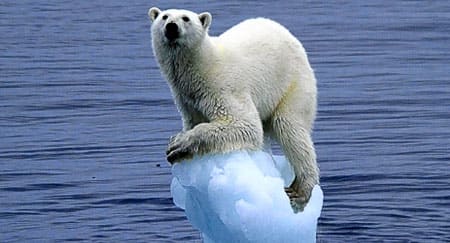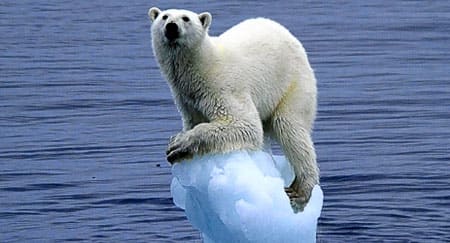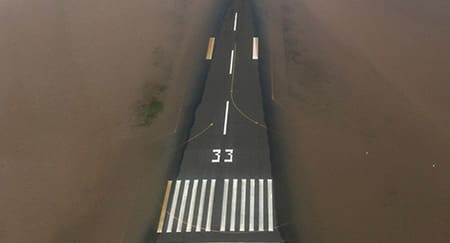Green issues are no longer the preserve of hippies and tree huggers. The military knows just how important they are. The BBC's environment correspondent, David Shukman, recounts how climate has become part of defence planning.
Until recently, if you were the sort of person who worried about the environment – and particularly about climate change – it would be highly unlikely that you would also be wearing a military uniform. Global warming was something to trouble Greenpeace. Compared to winning a war, saving the planet was too woolly a concept to merit attention, too vague to factor into planning.
No longer.
The potential implications of a shifting climate are gradually working their way onto the security agenda -- from the threat of rising seas swamping low-lying island bases like Diego Garcia to extreme weather disasters requiring massive rescue or relief operations to mass migrations heightening tensions and even triggering conflicts. Though hedged with huge uncertainties and unclear timings, these scenarios could involve armed forces.
Most immediate are the implications of a changing map. The Arctic, warming faster than the global average, is seeing its geography altered as the ice retreats. Suddenly, its natural resources are more accessible and border disputes, long forgotten beneath the ice, are now relevant. The US Coast Guard was among those to receive an Arctic wake-up call when it found itself having to patrol stretches of sea which had usually remained frozen.
On a C-130 flight over Alaska in September 2008, the region’s Coast Guard commander, Rear Admiral Gene Brooks, told me: "My job is to patrol the waters around the United States and there’s now a lot of water where there used to be ice, simple as that.
"I don’t care how it’s happening or why it’s happening but what I can tell you is that the ice is going and we’ve got to move in."
Admiral Brooks described the Arctic as a new frontier. And to bolster the Coast Guard’s presence, he despatched pioneering vessels and aircraft and established a forward position at Barrow. Challenges included maintaining logistics and communications over vast distances and deploying craft in unfamiliar waters -- and all on an accelerated timetable. For some years scientists have observed a steady decline in ice cover with most researchers predicting ice-free conditions in the summertime by the end of the century. But then in 2007 the annual melt reduced the ice to the extent forecast for 2055. Admiral Brooks described himself as stunned by the fact that great tracts of ice vanished so quickly.
In 2007, the European Space Agency detected that the fabled Northwest Passage, the sea-route connecting the Atlantic to the Pacific, was briefly ice-free.
One reason for his concern was the likelihood of increased shipping in America’s polar waters. In 2007, the European Space Agency detected that the fabled Northwest Passage, the sea-route connecting the Atlantic to the Pacific, was briefly ice-free. This raised the prospect of a new shipping-lane. Cruise ships and yachts were starting to use the passage and, if they ran into trouble, it would be the Coast Guard’s job to help them. The melt also raised tensions over control. The Northwest Passage twists between the islands of the Canadian Arctic archipelago and is regarded by the Canadian Government as part of its sovereign territory. The United States and many European countries argue that the waterway is wide enough to qualify as international.
Other polar disputes flared into the open as well. A Russian parliamentarian used mini-submarines to plant a Russian flag on the seabed at the North Pole to support his country’s claims. Danish and Canadian ministers scrambled North to do their own flag-waving. And Admiral Brooks warned that these disagreements between the Arctic nations were a recipe for disaster.
“With undetermined boundaries and great wealth,” he said, “the potential is there for conflict or competition. There's always a risk of conflict where you do not have established, delineated, agreed-upon borders.”
So the melting is the equivalent of lifting a rock and discovering threats underneath. But the implications of warming reach far beyond the Arctic and were explored in a landmark study by the Washington-based consultancy CNA in 2007. Guided by a panel of retired senior officers, it argued that climate change would not cause specific crises, more that it would act as “a threat multiplier for instability in some of the most volatile regions of the world”. This is a key observation.
While some environmental campaigners claim that global warming will mean – or already means – massive and instantaneous catastrophe, the fine print of the science is more nuanced. It suggests that the shifting weather patterns, brought about by climate change, could over time make tough situations worse.
"We will pay for this one way or another. We will pay to reduce greenhouse gas emissions today and we’ll have to take an economic hit of some kind. Or we will pay the price later in military terms. And that will involve human lives."
As the CNA report put it, the changes would exacerbate “already marginal living standards in many Asian, African, and Middle Eastern nations, causing widespread political instability and the likelihood of failed states.” In other words, regions becoming hotter or drier or stormier will experience an additional burden on existing strains. “Unlike most conventional security threats that involve a single entity, acting in specific ways and points in time, climate change has the potential to result in multiple chronic conditions, occurring globally within the same time frame.”
In his contribution to the report, General Anthony Zinni, former head of Central Command, spelled out a stark choice:
"We will pay for this one way or another. We will pay to reduce greenhouse gas emissions today and we’ll have to take an economic hit of some kind. Or we will pay the price later in military terms. And that will involve human lives."
Deliberately blunt, those words highlight the dilemma faced by the international community as it struggles to make progress in tackling the problem. For nearly two decades the UN Framework Convention on Climate Change, born at the Earth Summit in Rio in 1992, has hosted negotiations. Usually these are held at the level of environment ministers, though the talks in Copenhagen in December 2009 attracted dozens of heads of state and government including President Obama of the United States and Premier Wen of China. That event was described as the best chance for a generation to reach agreement. But it was marked by fractiousness and ended inconclusively.
The objective of this process has been deceptively simple: to draw up a binding global treaty to cut the greenhouse gases which scientists say are behind most of the recent warming. And the key facts are relatively straightforward too: last year was one of the hottest on record and was also the 34th consecutive year to be warmer than the global average temperature for the 20th century. At the same time, the levels of carbon dioxide, the key greenhouse gas, have risen every single year since the most accurate measurements began in 1958. And it’s well-established that carbon dioxide traps heat in the atmosphere.
China, the world’s largest emitter of greenhouse gases, regards itself as a developing country and argues that the developed world should lead the way in emissions cuts, itself refusing to be bound by international treaty
Most governments accept these basic tenets of the science and the core conclusion – that manmade emissions are behind most of the recent warming. And almost without exception, they call for urgent action in response. But the disputes in Copenhagen revealed the limitations of what they were prepared to do, and little has changed since then. China, the world’s largest emitter of greenhouse gases, regards itself as a developing country and argues that the developed world should lead the way in emissions cuts, itself refusing to be bound by international treaty. And the United States, the second biggest polluter, is unbending too. Despite President Obama’s expressed aim of joining a global effort, plans for a domestic climate bill failed in the Senate last year, making US participation in an international deal highly unlikely for the foreseeable future.
As a result, the most recent UN talks, at Cancun in Mexico in last December, only made modest advances on relatively minor issues. Meanwhile, the long years of talking have produced only one firm agreement to date: the Kyoto Protocol of 1997. At the time, that was a triumph of negotiation but it is due to expire in 2012 and anyway does not include China and the United States. The countries bound by its provisions – including the EU, Japan, Russia and Australia – are in no mood to continue beyond 2012 unless others join too. So, the prospects are poor for negotiating a new, more comprehensive treaty.
In the meantime, emissions keep rising. And climate scientists warn that with every passing year the chances of avoiding dangerous impacts later are reduced. There’s nothing certain about this; further warming does not mean instant trouble. Instead it’s more a question of probabilities: the higher the concentrations of greenhouse gas, the greater the likelihood of dangerous weather patterns in the decades ahead.
One of the first to frame global warming as a security issue was the former chief scientific adviser to the UK government, Professor Sir David King. He issued a stark warning: that climate change could ultimately prove more dangerous than terrorism. It’s too early to judge. The most hazardous impacts of warming are not forecast till the second half of this century or beyond. But, if the scientists are right, as time goes by the odds keep getting worse.



